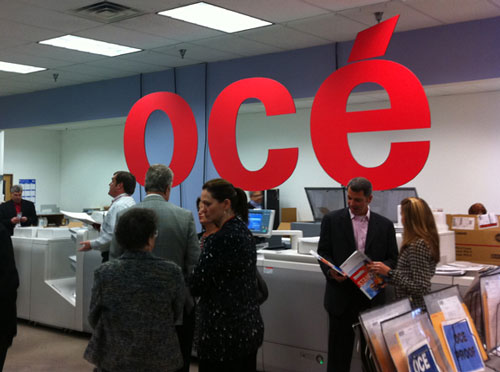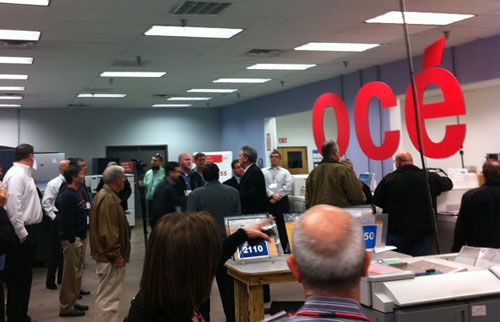Despite the best efforts of Mother Nature to complicate travel, nearly 50 printers from around the country ventured to an uncharacteristically icy Houston, TX, for Océ North America’s Envision the Future Forum, held February 2–4 at the Hotel Sorella and other locations around town. The event featured networking receptions, keynote presentations, strategy sessions, a stunning preview of bleeding-edge interactive print technologies, a print shop tour, and, as befitted the location, a Texas Hold’Em poker tournament.
The objective of the event was not so much to promote Océ products as it was to offer printers—be they present or prospective Océ customers—a look at some of the prevailing industry trends, as well as ideas, tips, and strategies for building their businesses. Francis McMahon, Océ North America’s VP of Marketing, kicked off a day of sessions with a keynote that laid out some of the prevailing trends in printing and, in particular, short-run color. McMahon also stressed that, for all the inroads color printing has made, “black-and-white is not dead.” He specifically cited on-demand books as a growth area for printers stimulated by, of all things, the growth of electronic books. “This is not good news for offset printers,” McMahon said, “but it’s great news for digital printers.”
For all the inroads color printing has made, “black-and-white is not dead.”
McMahon also spoke about the recent Canon acquisition and what it meant for Océ’s present customers, which is to say that any internal changes will be largely transparent, except insofar as Océ now supports equipment in the Canon ImagePRESS line, specifically, the ImagePRESS 7010VP.
Paul England, VP of Customer Development for Océ, spoke about the company’s Press Go! program, which had been launched at Graph Expo last October. One point he stressed about Press Go! was that it was, in large part, customer-designed, and is intended to not only support printers with their print production, but to help with overall business development. The Press Go program offers printers educational and instructional content in a variety of forms, be it printed material, Webinars, video sessions, live interactive virtual workshops, and other collaborative activities.
Figure 1: The Océ Envision the Future Forum included a tour of Houston, TX's Ideal Printers.

Océ had partnered with Houston’s Ideal Printers for the event, and Ideal’s owner and president Larry Vaughn led a morning session in which he stressed that one of the missions of today’s commercial printer is to constantly educate the customer about the value proposition of print, as well as to understand that print is only one “piece of the puzzle.” Other technologies such as the Internet, video, social media, Quick Response (QR) codes, augmented reality (AR), etc., are not competition for print, but rather, “These are your buddies!” One of the major themes of the entire Envision the Future Forum was to demonstrate that all of these “non-print” technologies can be integrated with print to make print truly interactive. It’s important, Vaughn said, that printers be quick to adapt to change.
Technologies such as the Internet, video, social media, QR codes, augmented reality, etc., are not competition for print, but rather, “These are your buddies!” —Larry Vaughn, president and owner, Ideal Printers
In another morning session, Ideal’s VP of Operations, Tim Gondre, led a morning session that focused on workflow automation and the role that automation is playing in Ideal’s growing kitting business. According to the company, daily orders can range from 100 to as many as 2,000 kits, which can have as many as six to nine different components that need to be printed, collated, assembled, and distributed. Some kits also need to be customized. Gondre’s presentation offered one such case study documenting a kitting project Ideal had recently completed for Webb Mason, a project which involved managing 3,000 separate elements. Pivotal to the completion of this project—and, in fact Ideal’s kitting business—is Océ’s VarioPrint 6160. “The Océ machine is very reliable, and is one reason we have so many Océ systems in our digital center,” said Larry Vaughn, owner and president of Ideal Printers. Ideal also has an Océ VarioStream 7550 continuous-feed system as well as a VarioPrint 2110 cut-sheet engine and two other VarioPrint 6000 series devices.
Envision the Future Forum attendees got to see all of this equipment in action with an afternoon spent touring Ideal’s Houston plant. Like many of the shops represented by Forum attendees, Ideal (founded in 1984) had at one time been an offset shop, but, as Vaughn pointed out during the tour, has shifted most of its work to digital presses. Wide-format printing is also a growing business for Ideal, and the company produces signage and other materials for local sports organizations.
During the tour, Ideal demonstrated the variable-printing on-demand capabilities of its Océ equipment by printing personalized magazines for each person on the tour. Finished copies tumbled out of the press as the equipment was being demonstrated.
Figure 2: Ideal Printers has largely transitioned from offset to digital printing—including a variety of Océ continuous-feed and cut-sheet presses.

Meanwhile, in a darkened conference room in Ideal’s headquarters, veteran print industry consultant Peter Lancaster was quite literally envisioning the future in a presentation that showcased some of the bleeding edge developments in what Lancaster calls “Print 2.0,” or turning print into a platform for launching interactive content. Some of what he was talking about is still under wraps, but his presentation and videos showed the next generation of QR codes and augmented reality. Smartphone cameras and associated apps or Webcams can work in tandem with printed materials to provide a much richer and rich media experience for users. In one demonstration utilizing a printed magazine with embedded codes, the printed publication itself functioned essentially like a Web browser.
Lancaster is quick to stress that it’s not just a question of understanding and implementing the technology, but also creating and adhering to a set of best practices so that the experience works flawlessly in delivering value to the customer.
Forum attendees were agape by the end of Lancaster’s session and that, coupled with all the other information they received over the course of the event, may have seemed overwhelming, but the folks we spoke with were enthusiastic about possibilities many of them never knew existed. The tour of Ideal was also deemed of great benefit; “It’s always good to see what other printers are doing,” was a typical elevator conversation.
Attendees were almost unanimous in touting the value of events such as the Envision the Future Forum for sharing ideas and strategies, and not only seeing how the equipment works, but how it fits into the larger workflow—and into one’s overall print business.










Discussion
Join the discussion Sign In or Become a Member, doing so is simple and free